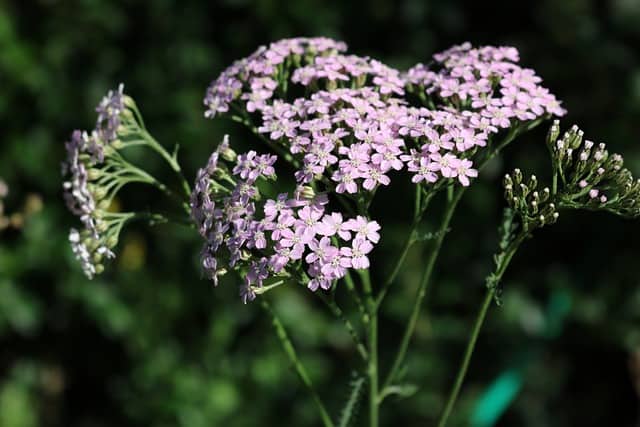Baby’s breath is known for its delicate, fluffy white blooms that resemble tiny clouds. While beautiful, this popular filler flower can spread aggressively in some regions. Luckily, many gorgeous flowers make excellent baby’s breath lookalikes. In this article, we’ll explore 7 stunning flowers that resemble baby’s breath.
Queen Anne’s Lace
With its airy clusters of tiny white blooms, Queen Anne’s lace (Daucus carota) bears an uncanny resemblance to baby’s breath. This common wildflower displays flat-topped flower heads atop lacy, fern-like leaves. It thrives in full sun and reaches 2-4 feet tall at maturity.
Though it can spread readily, Queen Anne’s lace attracts beneficial pollinators. It also serves as a host plant for black swallowtail butterflies. When foraging, be sure to correctly identify Queen Anne’s lace – it resembles the deadly hemlock plant.
Yarrow
Yarrow (Achillea millefolium) offers flat-topped blooms ranging from white to pink With its delicate, clustered flowers and lacy foliage, it closely mimics the look of baby’s breath Yarrow is drought tolerant once established and does well in full sun and poor, dry soils.
To control spread, opt for non-invasive cultivated varieties like ‘Paprika’ and ‘Summer Pastels’ Yarrow attracts butterflies while repelling deer, making it an excellent addition to wildflower gardens and borders
White Lace Flower
Aptly named, white lace flower (Orlaya grandiflora) provides an explosion of delicate white blooms strongly resembling baby’s breath. Each flower head contains hundreds of tiny florets. White lace flower has an airy, lightweight appearance with fern-like leaves below the blooms. It thrives in full sun and reaches 12-18 inches tall.
Sweet Alyssum
In white, purple, or pink, sweet alyssum (Lobularia maritima) offers masses of tiny cross-shaped blooms resembling baby’s breath. Use this short, mounding plant as a flowing groundcover or edging. Deadhead spent blooms to encourage more flowers.
To control self-seeding, start sweet alyssum from seed instead of cuttings. Plant it in full sun and average soil. Its short stature and continuous blooms make it ideal for tumbling out of walls and containers.
Greater Burnet
With its soft pink blooms, greater burnet (Pimpinella major ‘Rosea’) beautifully mimics the look of baby’s breath. This perennial displays airy flower heads held atop attractive green foliage. It thrives in full sun and reaches 2-3 feet tall when mature.
Greater burnet self-seeds readily, making it ideal for naturalized areas and meadow gardens. Prune spent blooms to encourage continuous flowering. Use it alongside ornamental grasses for gorgeous summer texture and color.
Ornamental Onions
Ornamental alliums like Allium christophii offer huge rounded blooms resembling purple fireworks. The flower heads contain hundreds of star-shaped purple florets, closely mimicking wispy baby’s breath. Alliums grow 1-3 feet tall depending on variety and do best in full sun and well-drained soil.
For lighter purple pom-poms reminiscent of baby’s breath, grow Allium ‘Gladiator’. Or try Allium karataviense for looser white blooms. The flower heads are long-lasting, making ornamental alliums ideal for borders, rock gardens, and cut arrangements.
Feverfew
Feverfew (Tanacetum parthenium) displays clusters of small white daisy-like blooms atop green ferny foliage. It spreads readily, making it perfect for tumbling over walls or as a flowing groundcover. For double blooms resembling baby’s breath, look for the ‘Snow Ball’ cultivar.
Aside from being ornamental, feverfew has many medicinal benefits. It eases migraines, arthritis pain, and inflammation. Grow feverfew in full sun to partial shade and prune spent blooms to encourage more flowers. It is also drought tolerant when established.
In conclusion, many stunning flowers beautifully mimic the delicate look of baby’s breath. For lightweight, airy texture in your garden, try Queen Anne’s lace, white lace flower, yarrow, or ornamental alliums. With their fluffy blooms and ferny foliage, these plants offer the same dreamy, romantic vibe as wispy baby’s breath.

Substitutions for Popular Focal Flowers
Focal flowers are your showstoppers! Typically, you’ll choose focal flowers in the main color scheme you’re going for since they are the star of your arrangement. They set the tone for your entire artistic creation, so choose wisely.
Rose Alternatives for Garden and Standard Varieties
| Rose Substitution | Colors |
|---|---|
| Double Tulip | White, Red, Shades of Pink, Orange, Yellow, Purple, Coral |
| Ranunculus | Red, White/Cream, Light Pink, Hot Pink, Yellow, Dark Purple, Maroon |
| Lisianthus | Cream, Light Yellow, Light Pink/Peach, Purple/Blue, Dark Purple/Black, Brown |

Rose substitutions: Large Ranunculuses have a similar look, feel, and air of elegance as roses. (heather payne)

In this arrangement, there are Roses and Ranunculuses. Can you identify which is which? (almond leaf)
Baby’s breath euphorbia accents landscapes
FAQ
What looks like baby’s breath but isn’t?
Feverfew – This bloom feels so country. If you like the look of baby’s breath for its country codes this is a great alternative. This is the flower used to make chamomile tea and it has such a wild whimsical look.
What are the small white flowers that look like babies breath?
The gypsophila plant is commonly known as “Baby’s Breath” due to its delicate, airy clusters of small white or pink flowers that resemble a soft, ethereal quality, evoking a sense of innocence and purity.
Are aster and baby’s breath the same?
Aster flower or better known as baby’s breath.
What is the difference between baby breath and gypsy flower?
The official gypsophila scientific name remains Gypsophila paniculata, but its common English name is baby’s breath. However, depending on the variety, you might also hear florists refer to it as: Gypso flower (short for gypsophila) Baby’s Breath flower (a shortened version of baby’s breath)
